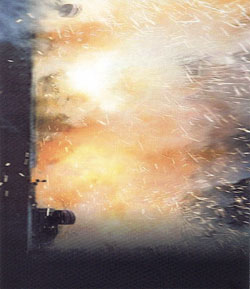Re: Motor contribution
I don?t have Ed?s very helpful ability to draw pictures and post them. So I?ll describe a picture, and you draw it at home. You will have had experience with analyzing series and parallel circuits, and what I describe below is just another one of those.
Draw a circle to represent an ?ideal? generator, meaning that it has no resistance. Draw a line up, and then to the right, draw a resistor symbol (label it ?Rg?), continue drawing the line to the right of the resistor symbol, and draw a dot. Label the dot ?P1.? What you have so far is a model of the generator, with its internal resistance ?Rg? being modeled as a separate component from the voltage source.
Continuing to the right, draw a line, then a breaker symbol (label it ?B1,? to represent the generator breaker). Draw the following things in order, as you continue to the right: line, resistor, line, dot (label ?P2?), line, resistor, line, breaker (label it ?B2,? to represent the branch circuit breaker for a motor), line, resistor, line, dot (label ?P3,? to represent the terminal connections at the motor), line, resistor (label it ?Rm,? to represent the internal resistance of the motor), line. At this point, draw the line down, then draw a circle (to represent the motor). Complete the circuit by drawing a line down, then all the way to the left, and finally back up to the first circle.
There are five resistors in this diagram. The ones on the far left (Rg) and far right (Rm) are internal resistances of the generator and the motor. The other three represent the resistance of the feeder and branch circuit conductors, and their numerical values include the resistance of the neutral or return path.
In normal operation, the ?ideal voltage source? will drive current along the path. There will be voltage drops through each of the resistances. When you first close all breakers, since the total resistance of the path is small, there is a large current (?starting current?). As the motor begins to turn, its windings will create a ?back emf,? which will work against the voltage from the generator, and will therefore reduce the current. That is why the running current is lower than the starting current.
Now draw a line from point P2 downwards, and connect it to the neutral return line. Label the connection point ?P4.? Point P2 is the fault point, and the line from P2 to P4 represents the short circuit path. You will see two separate circuits (two rectangles) that share this short circuit path. The left-hand circuit contains the generator. That path now has much lower resistance. The current will be very high, and all of the current will pass through the generator breaker ?B1.? The right-hand circuit contains the motor, but there is no longer a voltage source driving current into the motor. Rather, what you have is a motor with that ?back emf? still present. That is why the motor will now act as a generator. Current will flow upwards from the motor, and counter-clockwise through the right-hand path. This is the motor contribution to the fault current.
Several important points to make here:
</font>
- <font size="2" face="Verdana, Helvetica, sans-serif">Breaker B1 sees the higher current from the generator, but does not see the motor contribution current. Therefore, this fault scenario does not influence the selection and setting of the generator breaker.</font>
<font size="2" face="Verdana, Helvetica, sans-serif"></font>
- <font size="2" face="Verdana, Helvetica, sans-serif">Breaker B2 sees the motor contribution current, but does not see the current from the generator.</font>
<font size="2" face="Verdana, Helvetica, sans-serif"></font>
- <font size="2" face="Verdana, Helvetica, sans-serif">The short circuit path from P2 to P4 sees BOTH the generator current and the motor contribution current. If point P2 were to represent a sub-panel, and the fault were to occur inside that sub-panel, then the sub-panel would have to be rated to handle the total fault current from both sources.</font>
<font size="2" face="Verdana, Helvetica, sans-serif"></font>
- <font size="2" face="Verdana, Helvetica, sans-serif">The value of the motor?s internal resistance Rm, as used in this model, is not constant. For the first few moments, perhaps less than one cycle, it is very small, and the current is very high. This is the ?sub-transient period? that Ron mentioned, and the resistance is given the new name Rm?? (pronounced ?Rm double-prime?). (Edit: I should note here that ?Rm double-prime? is just my invented name for this discussion, and that the name Ron used, "X double-prime d," is the proper name.)</font>
<font size="2" face="Verdana, Helvetica, sans-serif"></font>
- <font size="2" face="Verdana, Helvetica, sans-serif">Over the next few cycles, as the motor begins to slow down, the value of internal resistance Rm gets higher. It is now called Rm? (pronounced ?Rm prime?), and the time period is called the ?transient period.?</font>
<font size="2" face="Verdana, Helvetica, sans-serif"></font>
- <font size="2" face="Verdana, Helvetica, sans-serif">Very quickly, perhaps within one second, the motor will slow down enough to cause the value of Eg to diminish to zero. At that time, the motor?s contribution to the fault current will have disappeared.</font>
<font size="2" face="Verdana, Helvetica, sans-serif">
One final note. Suppose you erase the line from P2 to P4, and then draw a line from P3 to P4. Think about what is different. Or try drawing a line from P1 to P4, and see what will change. This is the thought process of a short circuit study.
[ May 22, 2004, 01:15 PM: Message edited by: charlie b ]

